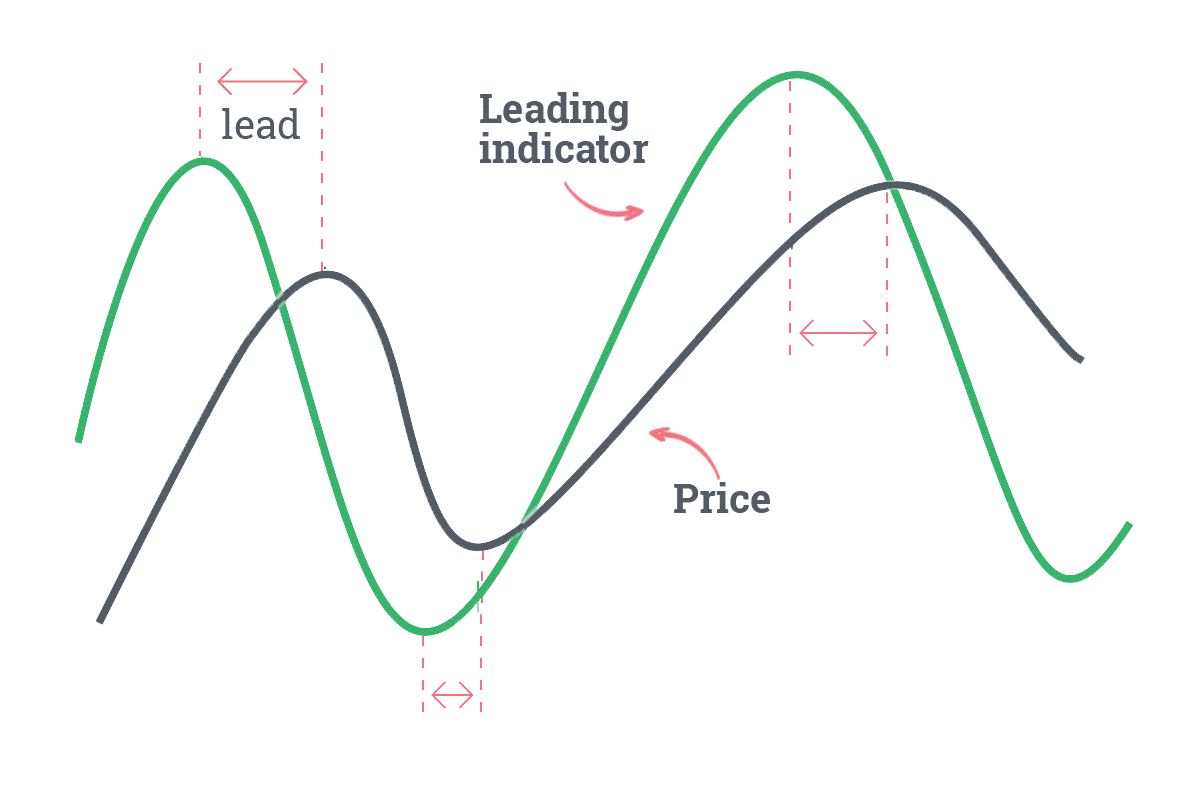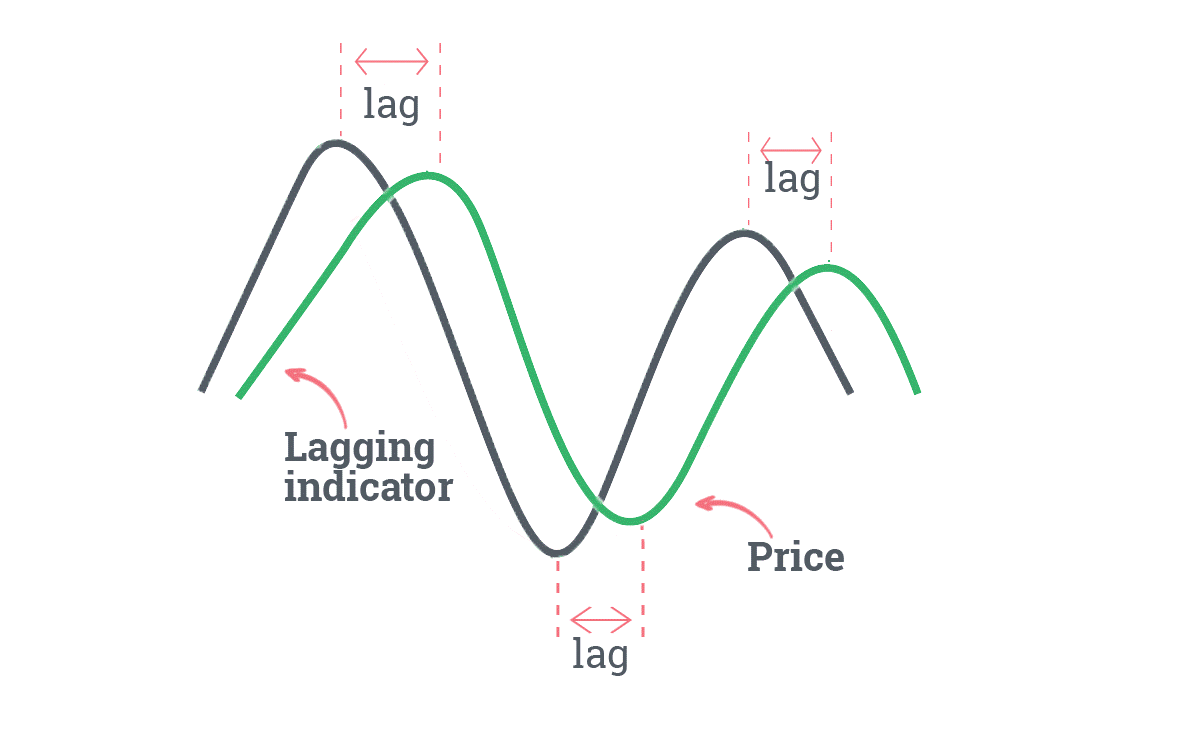Understand leading and lagging indicators in Forex
Leading indicators are like the early warning signals of the forex world. They provide traders with insights into potential price movements before they occur. These indicators are forward-looking, making them valuable tools for anticipating market trends and reversals. On the other hand, lagging indicators are historical in nature. They confirm trends that have already begun, serving as validation tools for traders' decisions.
Mastering the understanding and utilisation of leading and lagging indicators is akin to deciphering the market's intricate language. It empowers traders to make informed decisions, mitigate risks, and optimise their trading strategies. By discerning the nuances of these indicators, traders can enhance their ability to enter and exit positions at opportune moments, ultimately increasing their chances of success.
What are leading indicators?
Leading indicators are the proactive compass of the forex market, offering traders early signals of potential price movements. These indicators are characterised by their ability to precede price changes, making them invaluable tools for traders seeking to anticipate market shifts. Essentially, leading indicators act as predictive metrics that aid in gauging the market's future direction.
Several leading indicators are widely utilised in forex trading. These include, but are not limited to:
Relative Strength Index (RSI): RSI measures the speed and change of price movements, indicating overbought or oversold conditions. Traders use it to predict potential reversals.
Moving Averages: Moving averages, such as the Simple Moving Average (SMA) and Exponential Moving Average (EMA), help traders identify trends and potential trend reversals.
Stochastic Oscillator: The stochastic oscillator gauges the momentum of price movements and assists in identifying potential trend changes.
MACD (Moving Average Convergence Divergence): MACD measures the relationship between two moving averages and provides signals of trend direction and potential crossovers.
Leading indicators offer traders the advantage of foresight. By analysing these indicators, traders can identify potential entry and exit points before they materialise on price charts. For instance, if the RSI indicates an overbought condition, traders may anticipate a price reversal and adjust their trading strategies accordingly. Similarly, when moving averages cross over, it can signal the onset of a new trend. Utilising leading indicators effectively allows traders to make informed decisions, manage risk, and position themselves advantageously in the fast-paced world of forex trading.
What are lagging indicators?
Lagging indicators, in contrast to their leading counterparts, are retrospective in nature. They play a crucial role in validating and confirming trends and price movements that have already occurred. These indicators are often referred to as "follow-the-trend" indicators because they provide traders with a retrospective view of market behaviour. While they don't offer the predictive power of leading indicators, lagging indicators are indispensable for traders seeking to make informed decisions based on historical market data.
Several lagging indicators are widely used in forex analysis. These include:
Moving Averages (MA): Moving averages, although also used as leading indicators, are valuable lagging indicators. Traders use them to confirm trends and identify potential reversals. For example, a crossover of short-term and long-term moving averages may signal a change in trend direction.
Bollinger Bands: Bollinger Bands consist of a middle band (SMA) and two outer bands that represent standard deviations from the SMA. They help traders gauge price volatility and identify potential trend reversals.
Parabolic SAR (Stop and Reverse): Parabolic SAR is used to determine potential entry and exit points in trending markets. It provides trailing stop levels that move with the price, confirming the current trend.
Lagging indicators act as valuable confirmatory tools for traders. By analysing these indicators in conjunction with other technical and fundamental analyses, traders can validate the presence of a trend or a potential reversal. For example, if a moving average crossover aligns with other technical signals and fundamental factors, it strengthens the case for a trend reversal. Lagging indicators, when used judiciously, enhance a trader's confidence in their decisions, allowing for more precise entry and exit points and reducing the risk of false signals.

Key differences between Leading and Lagging indicators
Understanding the differences between leading and lagging indicators is pivotal for forex traders. At their core, these indicators diverge in their temporal orientation and roles in market analysis.
Leading Indicators:
Leading indicators, as the name suggests, take the lead in signalling potential price movements. They are forward-looking and attempt to predict future market conditions. Traders often use them to identify early trends and reversals.
Lagging Indicators:
Lagging indicators, on the other hand, follow price movements and validate past trends. They offer confirmation rather than prediction and are instrumental in providing traders with the assurance that a trend is genuine.

The pros and cons of using each type in forex trading
Leading Indicators:
Pros:
Early signals: Leading indicators offer traders the advantage of foresight, helping them identify potential opportunities before they fully develop.
Versatility: They can be used in various market conditions, including ranging and trending markets.
Cons:
False signals: Leading indicators are not foolproof and may produce false signals, leading to losses if not used judiciously.
Over-reliance: Relying solely on leading indicators can lead to impulsive decisions, as not all signals are guaranteed to materialise.
Lagging Indicators:
Pros:
Confirmation: Lagging indicators confirm trends, reducing the risk of acting on false signals.
Reliability: They are less prone to false signals and provide a more conservative approach to trading.
Cons:
Delayed information: Lagging indicators confirm trends after they have started, potentially causing traders to miss early entry points.
Limited predictive power: They do not predict future trends, making them less suitable for those seeking to capitalise on rapid market changes.
Practical application of Leading indicators
Leading indicators serve as valuable tools for forex traders looking to gain a competitive edge in the market. Let's explore some real-world scenarios where traders effectively use leading indicators:
Relative Strength Index (RSI): Traders often use RSI to identify potential trend reversals. When RSI readings move into overbought or oversold territories (typically above 70 or below 30), it may signal an impending price correction. For instance, if RSI indicates an asset is overbought, traders may consider selling or shorting the asset.
Moving Averages (MA): Moving average crossovers are a classic example. When a short-term moving average crosses above a longer-term one, it can signify the start of an uptrend, prompting traders to enter long positions. Conversely, a crossover in the opposite direction may indicate a downtrend and a potential short opportunity.
Interpreting leading indicators requires a nuanced approach. Here are some tips for traders:
Confirmation: Always seek confirmation from multiple leading indicators or other forms of analysis before making a trade. A single indicator may not provide a reliable signal.
Divergence: Pay attention to divergence between leading indicators and price movements. When an indicator's signal contradicts the price trend, it can indicate a potential reversal.
Risk management: Set stop-loss orders to limit potential losses, especially when using leading indicators. They are not infallible and can produce false signals.
Periodicity: Consider the timeframe you're trading on. Leading indicators may perform differently on shorter versus longer timeframes, so adjust your strategy accordingly.
Backtesting: Before implementing a new strategy based on leading indicators, conduct thorough backtesting to evaluate its historical performance.
Practical application of Lagging indicators
Lagging indicators are instrumental in validating trading strategies and confirming price movements. Here are practical examples of how traders use them:
Moving Averages (MA): Traders often use moving averages to confirm trends identified by other indicators. For instance, if a trader observes a bullish signal from a leading indicator, they may look for confirmation through the alignment of short-term and long-term moving averages in the same direction.
Bollinger Bands: Bollinger Bands help traders validate potential price reversals. When an asset's price touches or crosses the upper or lower band, it suggests overbought or oversold conditions, respectively. This can be used to confirm leading indicators' signals of trend exhaustion.
While lagging indicators are valuable, traders must exercise caution to avoid common pitfalls:
Delay: Recognize that lagging indicators provide confirmation after price movements have occurred. Avoid relying solely on them for timely entry and exit decisions.
Overcomplication: Avoid using too many lagging indicators simultaneously, as this can lead to analysis paralysis. Select a few that complement your trading strategy.
Ignoring Leading indicators: Don't overlook leading indicators entirely. A balanced approach that combines both leading and lagging indicators often yields the most comprehensive insights.
Choppy markets: In choppy or sideways markets, lagging indicators may produce false signals. Be mindful of market conditions and consider additional analysis.
Risk management: Set clear stop-loss and take-profit levels to manage risk, as lagging indicators alone do not guarantee success.
Combining Leading and Lagging indicators
In the complex landscape of forex trading, a powerful approach is to combine both leading and lagging indicators within a single trading strategy. This synergy leverages the strengths of each indicator type, offering traders a more comprehensive view of market dynamics. Here's how it works:
Leading indicators provide early signals, helping traders anticipate potential price movements. By identifying these signals, traders can plan their market entries and exits with precision. However, relying solely on leading indicators can be risky, as they are not always accurate.
Lagging indicators, on the other hand, act as a safety net, confirming the validity of a trend or reversal identified by leading indicators. They help traders filter out false signals, reducing the risk of making impulsive decisions.
Balancing the use of leading and lagging indicators is crucial for an effective trading strategy. Here are some strategies to strike that balance:
Signal confirmation: Use lagging indicators to confirm the signals generated by leading indicators. If both types align in the same direction, it strengthens the conviction in your trade.
Risk management: Incorporate leading indicators for timing your entries and lagging indicators to set stop-loss and take-profit levels. This helps manage risk effectively.
Market conditions: Adapt the balance based on market conditions. In trending markets, leading indicators may be more valuable, while lagging indicators can shine in ranging markets.
Experience and testing: Over time, you'll develop a sense of which indicators work best for your trading style. Continuously test and refine your strategy.
Conclusion
Leading indicators provide early signals, offering a glimpse into potential price movements before they unfold.
Lagging indicators serve as confirmatory tools, validating trends and reversals after they occur.
Balancing both types of indicators in your trading strategy can enhance decision-making, reduce risk, and increase overall effectiveness.
Effective interpretation and risk management are essential when using both leading and lagging indicators.


